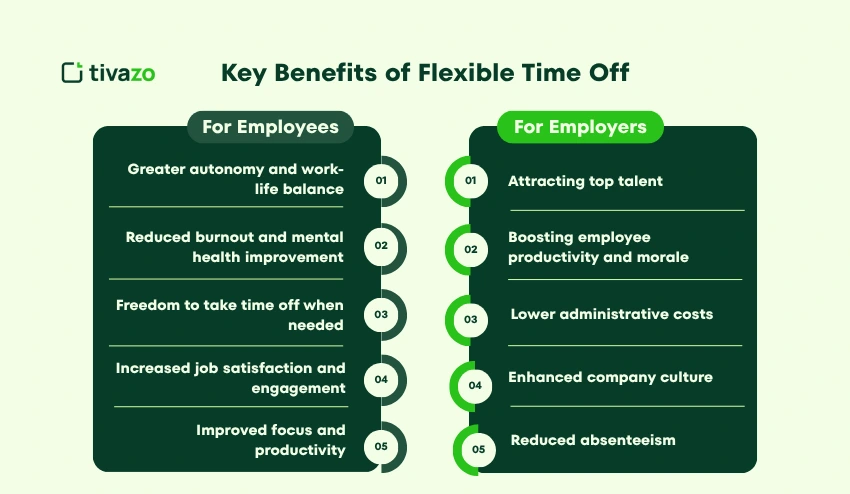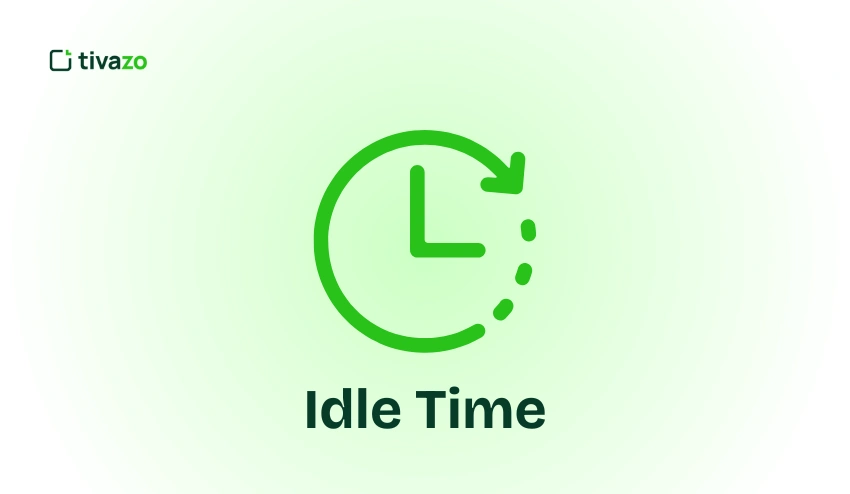Employee benefits are not only a perk in the present bustling and ever-changing work environment but also a necessity in attracting and retaining employees in the current labor force. Flexible Time Off (FTO) is one of the policies that have received much attention. In contrast to the conventional Paid Time off (PTO) policies when each employee has a specific number of days off, FTO gives a chance to the chance to take a leave at any time without fear of going through the set limit.
The trend is especially common in remote and hybrid work environments, the values of which place a high premium on flexibility and autonomy. The benefits of providing FTO are not only the ability of companies to promote employee wellbeing and mental health, but also the culture of trust and a productive environment. We are going to discuss all the details about FTO, the ways it operates, the advantages, the difficulties, and the best practices to implement it in the year 2026 in this complete guide.
Key Highlights:
- What Is Flexible Time Off
- Comparison of Flexible Time Off (FTO) to Traditional PTO
- How Does it Work
- Key Benefits of Flexible Time Off
- Challenges of Flexible Time Off
- Best Practices for Implementing Flexible Time Off
What Is Flexible Time Off (FTO)?
Flexible Time Off (FTO) is a leave policy where employees are given an opportunity to take paid time off whenever they need it without restriction to the number of days. FTO pools all leave into a single flexible pool instead of having a separate sick, vacation, and personal leave. Workers can spend their leisure time wherever they wish, they do not need time to accumulate it as was the case with the conventional policies. The major conditions are that workers should fulfill their work-related duties and overall seek management permission before taking a leave in order to maintain smooth operations.
How it works:
- Combined leave:
- FTO moves sick leaves, vacation, and personal days into a common non-specific pool of time in which employees may utilize this time any time they feel like.
- No accrual needed:
- Paid time off in the traditional PTO model takes time to accrue hours; in this case, employees do not have to earn time to take paid leave. FTO may be used at the moment.
- Manager approval:
- There is still a requirement that employees must seek leave in advance and have manager’s permission of such leaves at work, provided that the work is covered.
- Employee accountability:
- The FTO policy gives the employees the responsibility to own their time off on how to balance between the needs and work deadlines.
- None of the restrictions:
- Under FTO, there are no restrictions on the number of days an employee can take; moreover, each employee has more freedom in taking leave whenever he or she feels the need to take it without the concern of using up all his or her days
Brief Comparison of Flexible Time Off (FTO) to Traditional PTO (Paid Time Off)
Differences between Flexible Time Off (FTO) to Traditional PTO (Paid Time Off) are:
| Feature | Flexible Time Off (FTO) | Traditional Paid Time Off (PTO) |
|---|---|---|
| Leave Allocation | Unlimited or flexible leave based on need and company policy | Fixed number of days per year (e.g., 10 days) |
| Leave Flexibility | Employees manage their own time off with no set limits | Leave requests typically need approval based on the allocated days |
| Ideal for Remote Teams | Highly suited for remote or hybrid teams with varied schedules | Less flexible for remote or distributed teams |
| Accrual Requirements | No need to accrue leave; available when needed | Requires employees to accrue leave days over time |
| Manager Approval | Leave must be approved by managers, but there’s no fixed limit | Leave requests typically need approval based on allocated days |
How Does Flexible Time Off (FTO) Work?
Overview of the Mechanics of FTO
Within FTO, the staff members can take holiday whenever they want without fearing how many days they have in the annual leave quota. The point is that they may have the days off without pre-approval of the definite days provided that it would not impact their productivity and the deadline on projects. It is particularly useful in the industries where the focus is on a results-oriented workplace.
How Employees Request Time Off Under FTO
When employees intend to take time off, they just report to their managers and give them reasonable notice. This will avoid interference of the workflow. They might be required to make leave requests using a time-off tracking system or an in-house system, such as Tivazo, depending on the policies of different companies.
How FTO Integrates into Payroll and Time Tracking Systems
The leave management software such as Tivazo can be used to keep track of the FTO requests, time-off balances, and keep check with the company policies. Automating the time tracking of FTO will allow the company to control the leave more effectively and trace the effects on the productivity.
Key terms to understand:
- Open-ended FTO: The employees are allowed to take as much time off as they want, as long as it is reasonable.
- Tracking FTO: Leaves monitoring using systems.
- Manager Approval: Leaves would not have any effect on the productivity of the team.
Key Benefits of Flexible Time Off (FTO)
Key Benefits of Flexible Time Off for both Employees and Employers are:

Benefits For Employees:
1. Greater autonomy and work-life balance:
FTO will give employees the option of choosing their off-time whenever they want, which will promote better health work-life balance.
2. Reduced burnout and mental health improvement:
FTO helps prevent burnout and improves mental health by giving the employees control of their own leave.
3. Freedom to take time off when needed:
The number of days off that the employees have is not limited and they have a feeling that they are in control of their own time.
4. Increased job satisfaction and engagement:
The ability to take time off at their own convenience increases employee satisfaction and commitment to the job as they feel more committed to work.
5. Improved focus and productivity:
Employees who are allowed to have control over their own time off tend to work later with a refreshing and sharper mind to work more productively.
Benefits For Employers:
1. Attracting top talent:
A flexible time off policy is an enticing benefit that can be used to recruit and retention of the best talent.
2. Boosting employee productivity and morale:
Autonomous employees tend to be more motivated and productive at work.
3. Lower administrative costs:
FTO makes it easy to keep time off record because you do not have to follow the accruals, which makes it easy to manage time off, minimizing administrative overheads.
4. Enhanced company culture:
Flexible leave policy encourages culture of trust, enhances loyalty of employees and creates a good working atmosphere.
5. Reduced absenteeism:
Through FTO, employees will not call in sick at the last minute or burnout and thus absenteeism will be reduced and more regular productivity will be achieved.
How FTO Impacts Company Culture
Flexible time off (FTO) is one of the areas that influences the culture of a firm through promoting trust and independence. The fact that employees are allowed to manage their schedules enables FTO to empower them to own their time thereby fostering a culture of trust. Employees feel respected and important since they are allowed to take their time off whenever necessary and they are not micromanaged.
Also, FTO promotes the transition of the traditional time based work systems to the culture of results. It does not measure the quality and impact of the work delivered by the number of hours worked, but by quality and impact. The result of this change is that the level of productivity, job satisfaction and the general feeling of achievement among employees is increased since they feel they are trusted to achieve their targets and on their own time.
Challenges of Implementing Flexible Time Off (FTO)
Challenges of Implementing Flexible Time Off for both Employees and Employers are:

For Employees:
1. Guilt or Fear of Taking Time Off:
It is possible that employees will be guilty of spending too much time off, and might feel that others are not doing the same.
2. Overwork Leading to Burnout:
At other times, the employees might not take the leave, causing a burn out as they have unlimited time off.
Challenges For Employers:
1. Policy Ambiguity:
Without clear FTO policy guidelines one would be confused and may use it in a way that is not consistent, hence managers are unable to implement the policy properly.
2. Potential for Abuse:
FTO can cause overuse or abuse without proper management and supervision, which will result in a decline in productivity and an adverse effect on group performance.
3. Ensuring Fairness Across Teams:
Not all roles can be as flexible to utilize FTO, which can result in a sense of unfairness by employees as well as possible dissatisfaction.
Flexible Time Off vs Paid Time Off: What’s the Difference?
Comparison Chart of FTO vs PTO is:
| Feature | Flexible Time Off (FTO) | Paid Time Off (PTO) |
|---|---|---|
| Leave Allocation | Unlimited/Flexible | Fixed number of days |
| Employee Autonomy | High (take leave as needed) | Low (must adhere to fixed days) |
| Tracking | Monitored via software | Often tracked manually |
| Impact on Productivity | Results-driven | Time-based |
FTO and the Future of Time Off Policies
The Rise of Trust-Based Work Environments
With the companies shifting to more accommodating work arrangements such as hybrid work models, FTO is turning out to be a vital component of the changing work ability to manage employee leaves. The development of trustful conditions implies that the employees will not be rated at all based on the time they spend at the workplace but rather on the results of their work.
The Impact of AI and Analytics on Tracking FTO
Under the AI and analytics integration in FTO tracking systems, businesses can trace the usage of leaves in an efficient manner that will ensure that the policy is utilized efficiently without interfering with the productivity.
Best Practices for Implementing Flexible Time Off (FTO)
The effective implementation of Flexible Time Off (FTO) presupposes good communication, management, and culture promoting healthy work-life balance. The absence of these can result in FTO policies being inconsistent or insufficiently used, which will confuse employees and burn them out. Organizations are encouraged to embrace various best practices in order to make the policy deliver its utmost benefits. The practices would make the environment conducive to the use of FTO so that both employee satisfaction and team productivity are achieved. The following are the major best practices to be considered during FTO implementation:

- Give some clear-cut instructions about the way FTO will operate within your organization and that the employees are aware when and how they may utilize it.
- Train managers in order to be able to manage FTO and a healthy working environment.
- Monitor FTO requests with use of leave management software so that leave is distributed evenly and it does not have any impact on the team performance.
- Promote the culture of breaks: Be a role model: managers should take a vacation and encourage work-life balance.
- Measure usage and seek feedback: Measure the use of FTO by teams and receive frequent constructive feedback on the usage of the policy so as to determine whether it is achieving its intended purpose.
Conclusion: Is FTO Right for Your Business?
FTO is an effective instrument that encourages employee freedom, wellbeing, and job satisfaction and decreases burnout. FTO leads to the culture of trust, attracting the best, and raising the productivity of the companies. It is necessary to make sure that the policy is well-tracked and explicitly communicated before implementing FTO, which requires considering the needs of the team.
Nevertheless, it is also significant to review the effect of FTO on your business on a regular basis. Oversee the use patterns, receive feedback and make any adjustments to the policy when needed to ensure that it remains to serve the interest of both employees and the organization. In this way, you will have an efficient and flexible work environment that will serve all those concerned.




